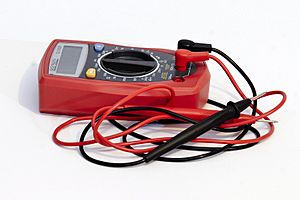Ohm facts for kids

When electricity flows through a material, some materials make it harder for the electric current to pass. This "difficulty" is called resistance. Materials that resist current flow are known as resistive materials. Examples include graphite, iron, and some man-made substances.
The amount of resistance a material has is measured in units called ohms. An ohm is shown by the Greek letter Ω (Omega). It is the official unit for resistance (R) in the SI system. The ohm helps us understand how much a material resists electricity.
Contents
What is Electrical Resistance?
Imagine electricity as water flowing through a pipe. If the pipe is narrow or has rough walls, the water flow slows down. This is similar to how electrical resistance works. Some materials have a "narrower" or "rougher" path for electricity, making it harder for the current to move.
Materials like copper wires have very low resistance, so electricity flows easily through them. Other materials, like the filament in an old light bulb, have high resistance. This resistance makes them heat up and glow when electricity passes through.
Understanding the Ohm
The ohm is the specific unit we use to measure how much resistance something has. The higher the number of ohms, the more resistance the material offers to the electric current. For example, a material with 100 ohms of resistance will block current more than a material with 10 ohms.
This unit is very important for engineers and electricians. It helps them design circuits and choose the right materials to make sure electricity flows safely and correctly.
Ohm's Law and Its Formula
The ohm is defined using a very important rule in electricity called Ohm's Law. This law connects resistance, voltage, and current.
- Voltage (V) is like the "push" or "pressure" that makes electricity move. It is measured in volts.
- Current (I) is the amount of electricity flowing, like how much water flows through a pipe. It is measured in amperes.
- Resistance (R) is how much the material resists the flow. It is measured in ohms.
Ohm's Law can be written as a simple equation:  This means that resistance (R) is equal to voltage (V) divided by current (I). So, if you know the voltage and the current, you can figure out the resistance in ohms!
This means that resistance (R) is equal to voltage (V) divided by current (I). So, if you know the voltage and the current, you can figure out the resistance in ohms!
Who Was Georg Ohm?
The unit "ohm" is named after a German physicist and mathematician named Georg Simon Ohm. He was born in 1789 and lived until 1854. Georg Ohm did a lot of important work studying electricity.
In 1827, he published his famous law, which showed the relationship between voltage, current, and resistance. His discoveries were a huge step forward in understanding how electricity works. Because of his important contributions, the unit of electrical resistance was named in his honor.
See also
 In Spanish: Ohmio para niños
In Spanish: Ohmio para niños

